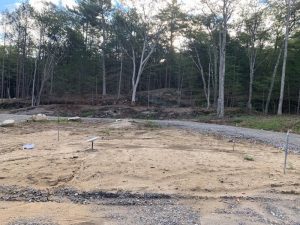What kind of garden can be planted over a septic field?
Question:
 I am a Master Gardener in Virginia, but I’m helping a friend start to think about her garden for a new house she is building in Maine. Only the garage has been completed this year, with the main house to follow next year. Her driveway wraps around a center section, which is also her septic field. I will be visiting her soon, and I want her to start with preparing the soil for appropriate plantings over a septic field. Where can we pick up a soil test kit? Is there an appropriate publication for septic field planting you can provide? I’ve already pulled a list of Maine native plants from the Native Gardens of Blue Hills, and I’m familiar with the Wild Seed Project website, but if you have anything that might be useful for me, please let me know. Finally, is it too late to plant a cover crop? If not, could you make a recommendation? I’ve attached a picture for your reference.
I am a Master Gardener in Virginia, but I’m helping a friend start to think about her garden for a new house she is building in Maine. Only the garage has been completed this year, with the main house to follow next year. Her driveway wraps around a center section, which is also her septic field. I will be visiting her soon, and I want her to start with preparing the soil for appropriate plantings over a septic field. Where can we pick up a soil test kit? Is there an appropriate publication for septic field planting you can provide? I’ve already pulled a list of Maine native plants from the Native Gardens of Blue Hills, and I’m familiar with the Wild Seed Project website, but if you have anything that might be useful for me, please let me know. Finally, is it too late to plant a cover crop? If not, could you make a recommendation? I’ve attached a picture for your reference.
Answer:
Elizabeth Stanley, Horticulture Community Education Assistant
It’s great that you’re using your Virginia Master Gardener Volunteer skills to help your friend!
This looks like it will be a big project, so encourage your friend to do it in stages based on observation over time. Here is more information, Designing your Landscape for Maine.
Septic/leach fields need to “breathe”, so deep rooted plants (and of course vegetables) are not appropriate. If the area is coastal, and/or has extensive ledge, the system needs to be especially well-functioning. Here are our fact sheets: Establishment of Vegetable Gardens on Septic System Disposal Fields and Bulletin #2442, Vegetable Gardens and Septic Fields Don’t Mix.
“The most suitable plants to grow on top of septic system disposal fields and fill extensions is grass. It is also permissible to grow flowers, but only if the soil is not roto-tilled and minimal watering is done. No plants that have woody roots should be planted on the disposal field or fill extensions since the roots might clog up pipes and other devices in the disposal field.”
It’s too late in the season to plant a cover crop, but the soil (or the well-drained material used in leach fields before top soil is applied) should be protected from erosion. Most contractors will have already installed silt fences or other erosion control materials, and will cover areas with straw or fabric to protect all surfaces from runoff.
UMaine Extension has extensive resources for Plants for the Maine Landscape in our Garden & Yard website.
The Wild Seed Project is a great resource for growing Maine’s native plants from seed. Others are Maine Audubon, Maine’s Soil & Water Conservation Districts, the Maine Natural Areas Program which includes invasive plant information, and local nurseries. For healthy lawns, visit Maine Yardscaping – Grass Seed Sources.
Soil test kits can be found at County Extension offices and also mailed by request. Be aware that with new construction, material is brought into the site. It can vary greatly in quality, depth, and from one area to another.
